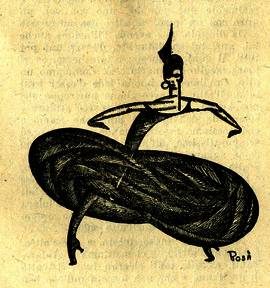
Rosa Rosà (1884-1978)

- Rosa Rosà: Danzatrice. In: Cronache d'attualità. Arte, scienza, letteratura, teatro, mode, sport, mondanità, Rome, May 1921
„La geniale viennese“ – this is how Filippo Tommaso Marinetti referred to Edyth von Haynau, born in Vienna on 11 November 1884, who became known as Rosa Rosà in Futurist circles. In 1908, Edyth von Haynau married the Italian author Ulrico Arnaldi (1878-1956), whom she had met on a cruise to the North Cape in 1907. After their wedding, they moved to Rome, where, between 1909 and 1915, she bore four children. In 1917 she came into contact with the Futurist group around L’Italia futurista and due to her many interests she did indeed fulfil Futurists' ambition to renew all spheres of art and life: in her Futurist phase she wrote a novel and multiple short stories, designed parole in libertà (Words-in-Freedom), created oil paintings, pastels, aquarelles, portraits, illustrations and ceramics. Throughout her life, Rosa Rosà was not only a versatile artist but also a campaigner within the feminist movement, who used her many skills to impress the Italian reading public with her enlightened ideas. She entered the spotlight of L'Italia futurista with the publication of "Le donne del posdomani" (The Women of the Near Future), participating in the vivid debates provoked by the publication of Marinetti's 'manual', Come si seducono le donne (How to Seduce Women, 1917). Other contributions analysed the positive development of new women's roles due to the absence of men during the Great War: "Risposta a Jean-Jacques" (An Answer to Jean-Jacques) and "Le donne cambiano finalmente" (Women Are Finally Changing). In addition, Rosa Rosà was one of the few female authors of parole in libertà (Words-in-Freedom). For example, Ricevimento – thé – signore – nessun uomo (Reception – Tea – Ladies – No Men, 1917) which was published in L'Italia futurista, just as well as the drawing Conflagrazione geometrica and the text Moltitudine and Romanticismo sonnambulo.
Furthermore she created book illustrations for works emerging from the Futurist circle gathered around L'Italia futurista…
Rosà’s ten drawings that supplement ten poems by Mario Carli in Notti filtrate (Filtered Nights, 1918), received Marinetti’s high praise. She also illustrated Corra’s Madrigali e grotteschi (1919) and Ginna's Le locomotive con le calze (The Trains that Wore Stockings, 1919). Her drawings translated the texts quite accurately into visual language. Her illustrations for Bruno Corra's 1917 edition of Sam Dunn è morto (Sam Dunn is Dead, 1917) were instead inspired by the esoteric and proto-Surrealist tendencies in the text. The novel emphasizes the protagonist's occult powers and the rôle of the unknown, and the six illustrations are an excellent example of how to represent 'states of mind'.
Her novel, Una donna con tre anime (A Woman with Three Souls, 1918), criticizes the classical image of a middle class woman and combines Futurist principles with a search for a gender identity and occult themes.
Little is known about her Futurist paintings, we can only get a vague impression of these works from a photograph of 1919, which shows the artist working on a drawing entitled Bandiere (Flags; published in Salaris: “Una donna con tre anime”, p.26).
Known are her drawing Danzatrice (Dancer) which accompanied Luigi Pirandello's novel Uno, nessuno e centomila (One, No One and One Hundred Thousand) in Bragaglia's magazine Cronache d'attualità; her later coloured drawing Mona Vanna (circa 1920), an oil painting from 1935, Anticolana alla fonte (Anticolana at the Source) and the figurative and imaginative illustrations for the The Persian Parrot Book (1922) and A Thousand and One Nights (1923) by Ernst Roenau. In the Sixties she revived her interest with the publication of two volumes: Eterno mediterraneo (Eternal Mediterranean, 1964) and Il fenomeno bisanzio (The Phenomenon of Byzantium, 1970).
Cited literature:
Fiumi, Maria Luisa: "Edyth Arnaldi (Rosà)." La donna: Rivista quindicinale illustrata 347 (20 Mai 1922): 23-24.
Marinetti, Filippo Tommaso, and Alberto Viviani: Firenze biondazzurra sposerebbe futurista morigerato. A cura di Paolo Perrone Burali D'Arezzo. Palermo: Sellerio, 1992.
Rosà, Rosa: Una donna con tre anime. A cura di Claudia Salaris. Milano: Edizioni delle Donne, 1981.
Rosà, Rosa: "Rosa Rosà's 'A Woman with Three Souls' in English Translation. Transl. Lucia Re and Dominic Siracusa. California Italian Studies 2:1 (2011): 1-39.




